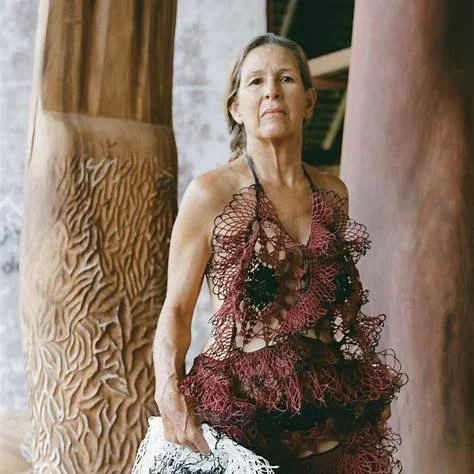Rachel Scott’s Diotima Debut: A Carnival of Culture and Resistance
When Rachel Scott unveiled Diotima’s first official runway collection at New York Fashion Week 2025, the show was more than a design debut—it was a declaration. Bathed in color, elevated in craft, and steeped in history, the collection paid homage to Caribbean carnival traditions and positioned Scott as one of the most intellectually engaging voices in fashion today.
Diotima Spring 2025 Presentation
From Kingston to New York: Rachel Scott’s Creative Roots
Scott’s creative DNA is formed in Kingston, Jamaica. She grew up with her mother’s boutique, learning early that style isn’t just aesthetics it’s survival, resourcefulness, identity. In interviews, Scott has spoken about making clothes for herself in high school, discovering creativity through limited resources.
This formative connection to materials, handwork, and heritage is foundational for Diotima. Her label, founded in 2021 during the pandemic, quickly became known for its distinctive blend of Jamaican craft—especially hand-crochet and traditional Manchester threadwork with New York tailoring sensibilities. (Vogue Business).
Carnival as Cultural Inspiration: Joy, Defiance, Heritage
Textural Play & Dramatic Silhouette
To understand the deeper resonance of Scott’s carnival influence, one must see Carnival in the Caribbean not as festivity alone but as a symbolic resistance. Carnival emerged in many islands as a way for enslaved Africans and then freed communities to reclaim space, identity, and voice in part through masquerade, music, costume, and dance.
Elements such as feathers, shells, beads, paillettes, and dramatic masquerade forms carry history: of colonial power, of suppression, but also creativity and defiance. When Scott draws on these, it’s not merely aesthetic borrowing; it’s activating a lineage. In her Spring 2026 Diotima show, she dedicated the collection to activist Claudia Jones, weaving together radical joy and political consciousness in the same breath.
Inside the Debut Collection: Crochet, Craft, and Color
Detailed Textile & Embellishment
At the NYFW show, Scott expanded Diotima’s visual language. She retained signature codes—crochet, shell-like paillettes, mesh, tactile handwork but pushed further: oversized feathers, bold color contrasts, sculptural silhouettes. The balance between sensual exposure and structured tailoring, playful exuberance and serious craft, was striking.
The choice of venue an intimate industrial Greenpoint space donated for the show reinforced the tight-knit personal energy that defines Scott’s world. It was not just spectacle; it was gathering.
The Politics of Resistance in Diotima’s Fashion Language
Part of what gives Scott’s work its depth is not only what the clothes look like, but how they’re made and who makes them. Diotima collaborates directly with Jamaican artisans, emphasizes non-extractive engagement, and hands things back to craft traditions rather than appropriating them.
Scott is vocal about the challenges of what she terms “luxury by immigrants, by Black women, with roots elsewhere.” Access to capital, visibility, and systemic bias are real. Her winning of CFDA Emerging Designer and later Womenswear Designer of the Year (2023–2024) is not just recognition, it’s rare validation in a field that often prizes legacy over diversity.
Craft, Collaboration, and Ethical Luxury
Fashion’s Expanding Definition of Luxury
Scott is helping redefine luxury as something more porous, more rooted. It’s about the hand, the heritage, the story, not just the brand name or price tag. Her work suggests that luxury consumers increasingly want meaning to connect with provenance, with narratives of identity.
The Power of Diasporic Aesthetics
Scott’s Jamaican roots aren’t a marketing angle; they’re intrinsic. As diasporic designers bring more of their cultural vocabulary onto major runways, fashion’s visual landscape becomes richer and more complex. Diotima’s debut suggests the industry is ready or close to lean into that richness rather than flatten it.
Ethics & Economic Equity as Design Pillars
In the wake of conversations around sustainability and ethical sourcing, Scott’s model working with artisans in Jamaica, fair collaboration, craft preservation provides a template. Luxury fashion has long had glossier outputs than ethical practices; Diotima flips that.
Broader Impact & Connections
Leadership in Transition: With Scott’s recent appointment as Creative Director of Proenza Schouler (while still leading Diotima), her voice may influence not only her own label but legacy houses too.
Awards & Visibility: Recognition through CFDA and other platforms has helped amplify her platform. That kind of visibility matters for funding, partnerships, retail availability.
Cultural Conversations: Her work enters broader dialogues on fashion equity, decolonization of aesthetics, and what it means to represent communities rather than commodify them.
Diotima’s Place in the Future of Fashion
Rachel Scott’s Diotima debut isn’t just fashion; it’s a reclamation. It's about Caribbean identity, joy, and resistance made visible and wearable. In an industry often chasing novelty, her work reminds us that rootedness and history can offer the most transformative narratives. As she extends her reach into leadership roles, into global runway conversations Scott is shaping something essential: a model of fashion that insists on beauty and justice.




